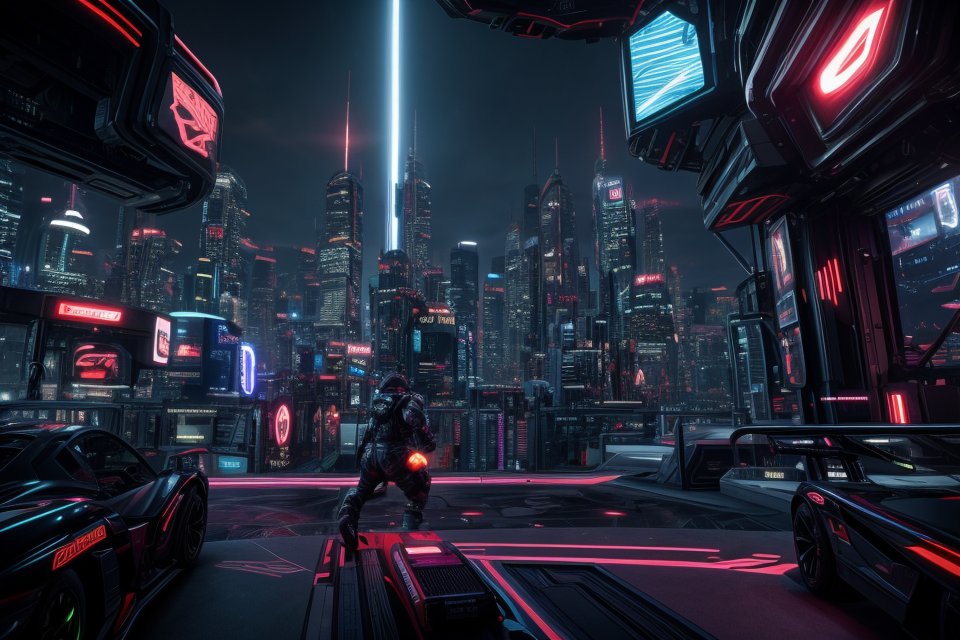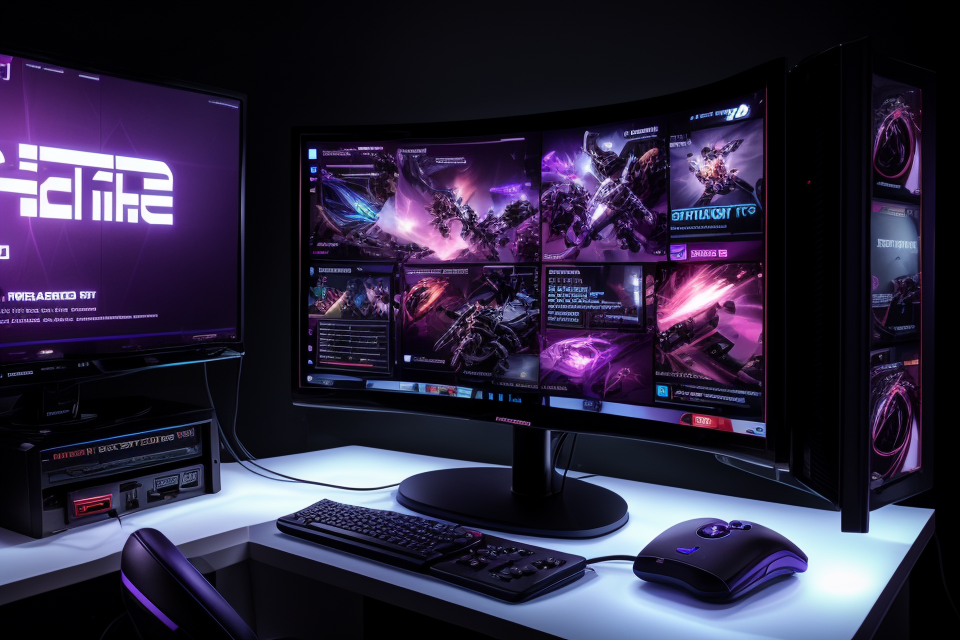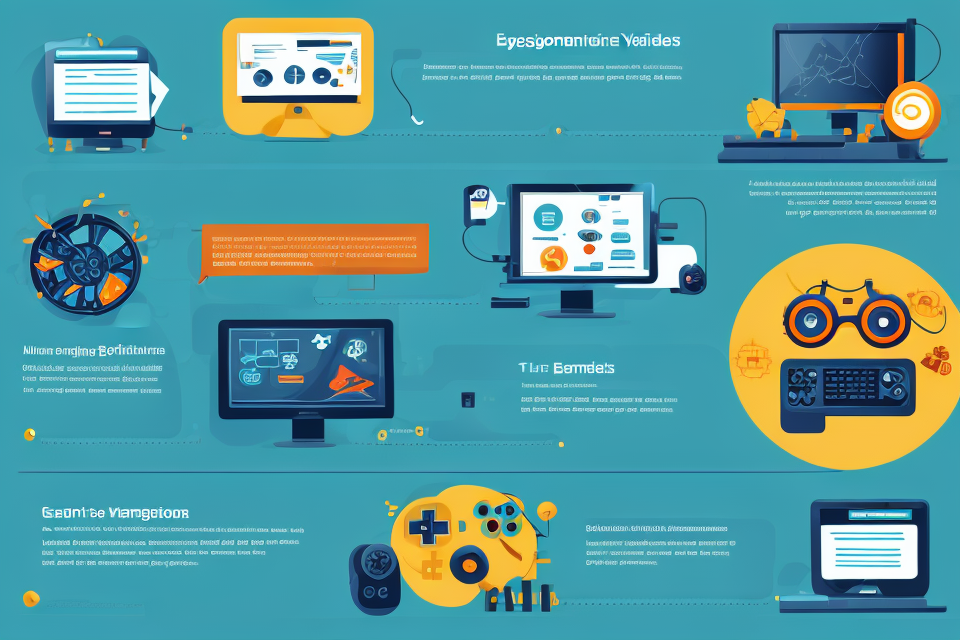
Gamers are often considered to be some of the most discerning and critical audiences out there. From the games they play to the hardware they use, they are always on the lookout for the best possible gaming experience. And one aspect that gamers tend to prioritize above all else is graphics. But why do gamers care so much about graphics? In this article, we’ll explore the reasons behind this obsession and why graphics play such a crucial role in the gaming experience.
Gamers often prioritize graphics in their gaming experience because they believe that graphics are a key component of the overall immersion and realism of a game. They may feel that graphics help to bring the game world to life and make it more engaging and enjoyable to play. Additionally, some gamers may believe that better graphics lead to a smoother and more seamless gaming experience, with fewer technical issues or glitches. Finally, graphics may also be seen as a sign of a game’s technical prowess and attention to detail, which can be a source of pride for gamers who enjoy showcasing their favorite games to others.
The impact of graphics on gaming experience
Visual aesthetics and immersion
In the world of gaming, visual aesthetics play a crucial role in creating an immersive experience for players. The graphics of a game are responsible for bringing the virtual world to life, and they can greatly impact a player’s perception of the game. Realistic and detailed graphics contribute to the overall immersive experience by making the game world feel more believable and authentic.
When a game’s graphics are of high quality, players are more likely to become fully engrossed in the game world. The more realistic and detailed the graphics, the more players are able to suspend their disbelief and become fully immersed in the game. This can lead to a more enjoyable and satisfying gaming experience, as players are able to fully engage with the game world and its characters.
In addition to creating a more immersive experience, high-quality graphics also contribute to the overall aesthetic of the game. A game with visually stunning graphics is more likely to stand out among the sea of other games, and players are more likely to be drawn to it. This can be especially important for games that rely heavily on visuals, such as racing games or first-person shooters.
Overall, the graphics of a game have a significant impact on the gaming experience. They contribute to the overall immersive experience by making the game world feel more believable and authentic, and they also play a role in the game’s aesthetic appeal. As technology continues to advance, it is likely that the importance of graphics in gaming will only continue to grow.
Smooth gameplay and performance
- The relationship between graphics and frame rate
- The impact of high-quality graphics on the responsiveness and fluidity of gameplay
Smooth gameplay and performance are crucial aspects of a positive gaming experience. The relationship between graphics and frame rate is significant in this regard. Frame rate refers to the number of frames rendered per second, and it directly affects the smoothness of the gameplay. Higher frame rates result in smoother animations and faster response times, leading to a more immersive and responsive gaming experience.
High-quality graphics also play a significant role in enhancing the smoothness of gameplay. When games have high-quality graphics, they are designed with attention to detail, which leads to a more realistic and engaging gaming experience. High-quality graphics can also enhance the responsiveness of the game, making it more enjoyable to play. For example, in fast-paced games, high-quality graphics can make it easier for players to see their enemies and respond accordingly, leading to better gameplay.
Furthermore, high-quality graphics can enhance the fluidity of gameplay. Fluidity refers to how well the game transitions between different scenes and actions. High-quality graphics can make these transitions smoother, which leads to a more seamless gaming experience. This is particularly important in open-world games, where players need to be able to move freely and seamlessly between different areas.
In conclusion, the impact of graphics on smooth gameplay and performance cannot be overstated. High-quality graphics can lead to higher frame rates, which enhance the responsiveness and fluidity of gameplay. This leads to a more immersive and enjoyable gaming experience for players.
Factors influencing gamers’ preference for high-quality graphics
Hardware capabilities
Gamers prioritize graphics in their gaming experience for a variety of reasons, and one of the primary factors that influence this preference is the hardware capabilities of the gaming system. The role of hardware in determining the quality of graphics is significant, as it plays a crucial role in the overall gaming experience.
One of the main reasons why hardware capabilities are so important to gamers is that they directly impact the performance of the game. High-quality graphics require a significant amount of processing power, and a gaming system that is not equipped with the necessary hardware will struggle to produce the high-quality visuals that gamers have come to expect. This can result in a subpar gaming experience, and may even cause the game to crash or freeze.
In addition to the performance of the game, hardware capabilities also impact the level of realism that can be achieved in the game’s graphics. Advanced hardware such as high-resolution displays and powerful graphics cards allow for more detailed and realistic visuals, which can significantly enhance the immersive experience of the game. This is particularly important for gamers who are looking for a more realistic and engaging gaming experience, as the level of realism in the graphics can greatly impact their level of immersion in the game.
Furthermore, advancements in technology have also played a significant role in driving gamers’ expectations for high-quality graphics. As hardware capabilities have improved over time, gamers have come to expect more from their gaming systems, and are willing to invest in high-end hardware in order to achieve the best possible gaming experience. This has led to a greater emphasis on graphics in the gaming industry, as developers strive to create games that can take full advantage of the latest hardware advancements.
In conclusion, hardware capabilities play a crucial role in determining the quality of graphics in gaming, and are a key factor in gamers’ preference for high-quality graphics. As hardware continues to advance, it is likely that gamers will continue to expect and demand ever-increasing levels of realism and immersion in their gaming experiences.
Competitive gaming and esports
The impact of high-quality graphics on competitive gaming and esports
In competitive gaming and esports, every advantage counts. High-quality graphics can provide players with critical information that can impact the outcome of a game. For example, in first-person shooter games, high-quality graphics can make it easier for players to spot their opponents, giving them a strategic advantage.
Moreover, high-quality graphics can enhance the overall gaming experience, making it more immersive and engaging. This can be particularly important in esports, where players often compete in front of large audiences. High-quality graphics can help create a more cinematic experience, making the game more enjoyable to watch and increasing the popularity of the sport.
The role of graphics in enhancing strategic gameplay and providing a fair playing field
High-quality graphics can also play a critical role in enhancing strategic gameplay in competitive gaming and esports. For example, in real-time strategy games, high-quality graphics can make it easier for players to assess the battlefield and make informed decisions. This can lead to more strategic gameplay and more exciting matches.
Additionally, high-quality graphics can help create a fair playing field by reducing the impact of technical issues. In esports, even small technical issues can have a significant impact on the outcome of a game. High-quality graphics can help reduce the likelihood of technical issues, ensuring that the game is played on a level playing field.
Overall, high-quality graphics can have a significant impact on competitive gaming and esports. They can provide players with critical information, enhance the overall gaming experience, and help create a fair playing field. As a result, many gamers prioritize graphics in their gaming experience, as they recognize the importance of high-quality graphics in competitive gaming and esports.
The relationship between graphics and gameplay
Balancing graphics and gameplay
The challenges of maintaining a balance between graphics and gameplay
One of the most significant challenges in maintaining a balance between graphics and gameplay is the complexity of each element. Graphics are an essential part of the overall gaming experience, but they can also be quite demanding in terms of hardware requirements. On the other hand, gameplay mechanics and experience are the heart of any game, but they can be quite difficult to design and implement.
A game developer must consider various factors when trying to balance graphics and gameplay. These factors include the type of game, the target audience, the hardware requirements, and the budget. For example, a first-person shooter game might require high-end graphics to provide an immersive experience, but this might not be necessary for a puzzle game.
Another challenge is that graphics and gameplay are interdependent. High-quality graphics can enhance the gameplay experience, but poor graphics can detract from it. This means that game developers must be careful to ensure that the graphics they include are not only visually appealing but also complement the gameplay mechanics.
The importance of prioritizing gameplay mechanics and experience over purely aesthetic elements
While graphics are an essential part of the gaming experience, they should not be the only focus for game developers. Prioritizing gameplay mechanics and experience over purely aesthetic elements is crucial to creating a well-rounded and engaging game.
Gameplay mechanics are what make a game fun to play. They are the rules, the controls, and the interactions that players engage in. Without good gameplay mechanics, a game can be frustrating and unengaging, even if it has top-notch graphics.
The experience that a game provides is also essential. This includes the story, the characters, and the emotions that players feel while playing. A game with stunning graphics but a poor storyline or lackluster characters may not be as engaging as a game with weaker graphics but a compelling storyline and memorable characters.
In conclusion, while graphics are an essential part of the gaming experience, they should not be the only focus for game developers. Prioritizing gameplay mechanics and experience over purely aesthetic elements is crucial to creating a well-rounded and engaging game. Game developers must balance these elements carefully to create a game that is both visually appealing and fun to play.
The role of graphics in storytelling and narrative
- The use of graphics to enhance storytelling and world-building
- The integration of visual elements in game design to convey plot, characters, and setting
- The role of graphics in creating a cohesive and immersive game world
- The impact of high-quality graphics on the emotional impact and immersion of narrative elements
- The ability of graphics to evoke emotions and create a sense of realism in the game
- The effect of graphics on the player’s engagement and connection to the game’s story and characters
In today’s gaming industry, graphics play a crucial role in enhancing the overall gaming experience. One of the key aspects of graphics is their ability to support and enhance the game’s narrative and storytelling elements. In this section, we will explore the role of graphics in storytelling and narrative and how they impact the player’s emotional engagement with the game.
One of the primary functions of graphics in gaming is to enhance the game’s world-building and storytelling elements. Graphics are used to create a cohesive and immersive game world that players can become fully engrossed in. The visual elements in a game, such as character models, textures, and environments, are designed to convey the game’s plot, characters, and setting.
For example, in games like “The Last of Us,” the graphics are used to create a post-apocalyptic world that is both believable and terrifying. The attention to detail in the graphics, from the weather effects to the ruined buildings, helps to immerse the player in the game’s world and create a sense of realism. This level of detail also helps to create a strong emotional connection between the player and the game’s characters and story.
Another aspect of graphics’ role in storytelling is their ability to evoke emotions in the player. High-quality graphics can create a sense of realism in the game, making the player feel like they are truly a part of the game’s world. This sense of realism can help to create a strong emotional connection between the player and the game’s characters and story.
For example, in games like “Red Dead Redemption 2,” the graphics are used to create a sense of realism in the game’s world, from the detailed character models to the beautiful landscapes. This level of realism helps to immerse the player in the game’s world and create a strong emotional connection to the game’s characters and story.
In conclusion, the role of graphics in storytelling and narrative is crucial in enhancing the overall gaming experience. Graphics are used to create a cohesive and immersive game world, as well as evoke emotions in the player. High-quality graphics can help to create a strong emotional connection between the player and the game’s characters and story, making the game more engaging and enjoyable.
The future of gaming visuals
Advancements in technology and graphics
As technology continues to advance, so too do the capabilities of gaming visuals. In recent years, there has been a significant increase in the quality of graphics in video games, with developers pushing the boundaries of what is possible.
One of the key factors driving this improvement is the increased processing power of gaming hardware. The latest console and PC hardware are capable of rendering complex, high-resolution graphics at high frame rates, which has enabled developers to create more detailed and realistic game worlds.
In addition to hardware advancements, there have also been significant improvements in software and programming techniques. Game engines like Unity and Unreal Engine have become increasingly sophisticated, providing developers with powerful tools to create highly detailed and realistic environments, characters, and objects.
Another important factor is the rise of emerging technologies such as virtual reality (VR) and augmented reality (AR). These technologies have the potential to revolutionize the way we experience games, by immersing players in fully-realized virtual worlds that feel truly lifelike. As VR and AR technology continue to improve, it is likely that we will see even more advanced gaming visuals in the future.
Overall, the combination of hardware advancements, software improvements, and emerging technologies is driving the future of gaming visuals forward, and it is likely that we will continue to see significant improvements in the quality and realism of game graphics in the years to come.
The role of graphics in shaping the future of gaming
- Graphics play a crucial role in shaping the future of gaming as they are the visual representation of the game world and the player’s interactions within it.
- Graphics can provide a more immersive experience for players, making them feel like they are truly a part of the game world.
- This can lead to increased engagement and longer play sessions, as players are more invested in the game.
- Graphics can also be used to convey important game information, such as the location of enemies or power-ups, which can impact gameplay and strategy.
- This can give players a competitive edge and make the game more challenging and enjoyable.
- Graphics can also be used to showcase new technologies and capabilities, such as realistic lighting or advanced physics simulations, which can drive innovation in the gaming industry.
- This can lead to the development of new genres and gameplay mechanics, as well as improvements in existing ones.
- Graphics can also be used to tell a story or convey emotions, which can enhance the overall narrative and impact of the game.
- This can make the game more memorable and increase its replay value.
- Graphics can also be used to create a unique visual style or art direction, which can help a game stand out in a crowded market and attract a dedicated fan base.
- This can lead to the game becoming a cultural phenomenon and influencing the broader gaming industry.
- Graphics can also be used to create a more accessible and inclusive gaming experience, such as by including options for customization or accessibility features.
- This can help to expand the reach of the game and make it more appealing to a wider audience.
- Graphics can also be used to create a more competitive and social gaming experience, such as by including online multiplayer or leaderboards.
- This can help to foster a sense of community and connection among players, and encourage them to keep playing and improving.
- Graphics can also be used to create a more personalized and customizable gaming experience, such as by including user-generated content or customizable game modes.
- This can help to increase player engagement and loyalty, and encourage them to keep coming back to the game.
- Graphics can also be used to create a more seamless and intuitive gaming experience, such as by including better controls or more responsive gameplay.
- This can help to improve the overall quality of the game and make it more enjoyable for players.
- Graphics can also be used to create a more immersive and interactive gaming experience, such as by including augmented or virtual reality features.
- This can help to revolutionize the gaming industry and create new possibilities for player interaction and engagement.
- Graphics can also be used to create a more strategic and tactical gaming experience, such as by including more realistic physics or better AI.
- This can help to make the game more challenging and rewarding, and encourage players to develop new strategies and tactics.
- Graphics can also be used to create a more cooperative and collaborative gaming experience, such as by including multiplayer or team-based game modes.
- This can help to foster a sense of community and teamwork among players, and encourage them to work together to achieve a common goal.
- Graphics can also be used to create a more challenging and rewarding gaming experience, such as by including more difficult levels or better rewards.
- This can help to make the game more satisfying and rewarding for players, and encourage them to keep playing and improving.
- Graphics can also be used to create a more diverse and inclusive gaming experience, such as by including a
- Graphics can provide a more immersive experience for players, making them feel like they are truly a part of the game world.
FAQs
1. Why do gamers care about graphics in games?
Gamers care about graphics in games because they significantly impact the overall gaming experience. Graphics are responsible for creating an immersive environment, which makes the game more enjoyable and engaging. High-quality graphics also contribute to better gameplay, making it easier for players to navigate and interact with the game world. As a result, gamers prioritize graphics as they play a crucial role in the gaming experience.
2. What is the relationship between graphics and gameplay in gaming?
The relationship between graphics and gameplay in gaming is quite interdependent. Graphics are a key component of the gameplay experience, as they provide visual cues that help players understand the game environment and navigate through it. Good graphics also contribute to a more immersive experience, which can enhance a player’s engagement with the game. In addition, high-quality graphics can improve the performance of the game, making it more responsive and smoother to play.
3. How do graphics impact the overall gaming experience?
Graphics have a significant impact on the overall gaming experience. They play a crucial role in creating an immersive environment that draws players into the game world. High-quality graphics can also enhance the gameplay experience by providing clear visual cues that help players understand the game mechanics and navigate through the game world. Moreover, graphics can affect the performance of the game, impacting its responsiveness and frame rate. As a result, gamers prioritize graphics as they are a key factor in the overall gaming experience.
4. What is the importance of graphics in different genres of games?
The importance of graphics varies across different genres of games. For example, in first-person shooter games, graphics are crucial for creating a realistic and immersive environment that enhances the gameplay experience. In role-playing games, graphics play a significant role in creating a vivid and engaging world that draws players into the story. In sports games, graphics are essential for accurately representing the players, teams, and stadiums, which can impact the authenticity of the game. Overall, the importance of graphics in different genres of games depends on the specific needs of the genre and the expectations of the players.
5. Can graphics be too realistic in games?
While high-quality graphics are important for creating an immersive gaming experience, there can be a point where graphics become too realistic. This can lead to a loss of the game’s identity and uniqueness, as well as impact the performance of the game. Additionally, too realistic graphics can sometimes be unsettling or disturbing to players, which can detract from the overall gaming experience. Therefore, there is a balance between high-quality graphics and the overall gaming experience that gamers prioritize.


